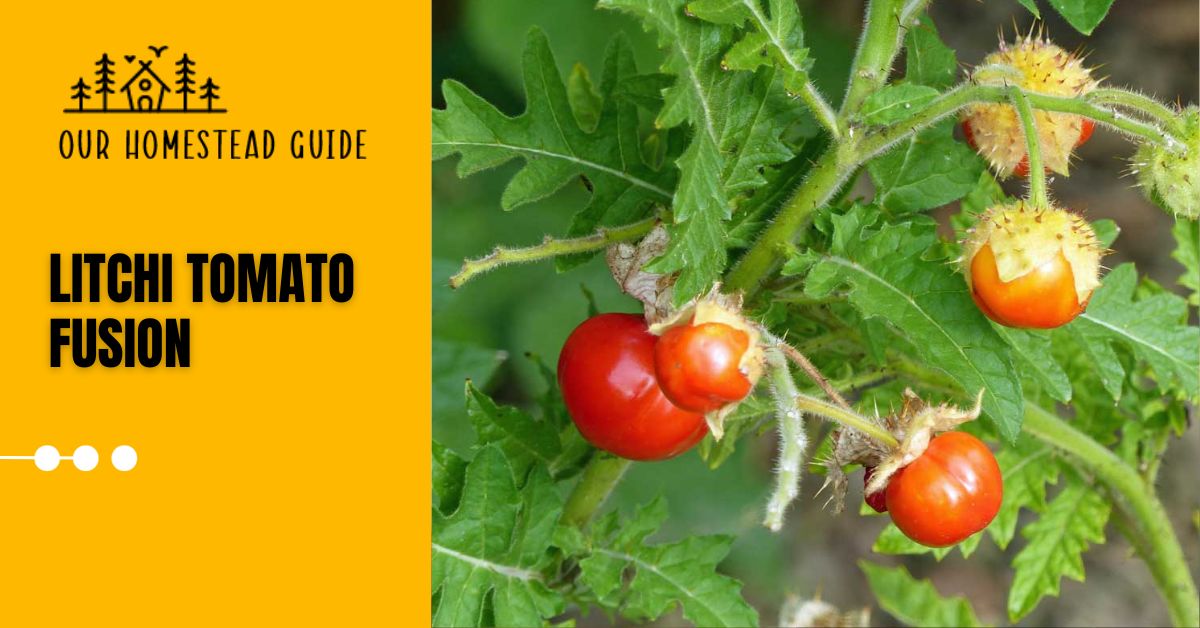Litchi Tomato Fusion: Where Sweetness Meets Freshness
Litchi Tomato Fusion Due to a renewed interest in heritage gardening, the lychee tomato, also known as morel de bulbous, is gaining popularity in over 200 community gardens. Its Latin name, Solanum sisymbriifolium, alludes to its kinship with nightshade, tomatoes, and eggplants. These little fruits have scarlet exteriors and delicate, silky golden flesh when sliced open.
Certainly, here’s a quick list of ingredients for “Litchi Tomato Fusion”:
| Ingredient | Quantity |
| Lychee | As needed |
| Cherry tomatoes | As needed |
| Red onion | 1 medium, thinly sliced |
| Fresh basil leaves | 1 cup, chopped |
| Olive oil | 2 tablespoons |
| Balsamic vinegar | 2 tablespoons |
| Salt and pepper | To taste |
How to Litchi Tomato Fusion?
Ingredients:
- Lychee tomatoes
- Cherry tomatoes
- Red onion
- Fresh basil leaves
- Olive oil
- Balsamic vinegar
- Salt and pepper to taste
1-Prepare the Lychee Tomatoes as follows:
Obtain ripe lychee tomatoes. These are the bigger ones, around the size of cherry tomatoes.
Remove the husk gently to uncover the fruit inside. To get the finest flavor, make sure they’re fully ripe.
2-Prepare the Cherry Tomatoes as follows:
Rinse and cut the cherry tomatoes in half.
3-Cut the Red Onion:
Slice a red onion into thin slices. You may change the quantity to suit your tastes.
4-Fresh basil, chopped:
Take a few fresh basil leaves and carefully chop them. The basil complements the sweetness of the lychee tomatoes.
5-Prepare the Salad:
Combine the lychee tomatoes, cherry tomatoes, red onion pieces, and basil leaves in a large mixing basin.
6-Make the dressing:
In a small mixing dish, combine 3 parts olive oil and 1 part balsamic vinegar. Adjust the ratio to your preference. To enhance flavor, season the dressing with a touch of salt and pepper.
7-Salad Dressing:
Drizzle the dressing of olive oil and balsamic vinegar over the salad components. To coat all of the components uniformly, toss lightly.
8-Chill before serving:
You may chill the salad for approximately 30 minutes to allow the flavors to mingle, or serve it right away.
9-Enjoy:
Serve your Lychee Tomato Fusion Salad as a light side dish or as an interesting starter. The mix of lychee and cherry tomatoes results in a delectable balance of sweet and acidic tastes.
Litchi Tomato
Native to South America, the litchi tomato, sometimes called Morelle de Balbis, is a distinct and tasty tomato cultivar. It belongs to the same family as peppers, potatoes, and eggplants—the nightshade family.
Litchi tomatoes are tiny, with a diameter of typically 1-2 inches. Their exterior is a vivid crimson color and they have a smooth, spherical form. The creamy, mellow flavor of the orange-yellow internal flesh is sometimes compared to that of litchi fruit.
Litchi tomatoes are high in potassium and rich in vitamins A and C. They are minimal in fat and calories as well.
Litchi tomatoes are a fruit with several uses; they can be cooked, preserved, or consumed raw. They are frequently added to chutneys, salsas, and salads. They may be cooked and added to stews, soups, and sauces.
Growing litchi tomatoes is not that difficult. They may be planted in the spring or fall, and it will take them 70–80 days to bear fruit. Litchi tomatoes want soil that drains well and abundant light.
The following advice will help you cultivate litchi tomatoes:
- Lightchi tomatoes should be planted in a sunny spot with well-drained soil.
- Before planting, amend the soil with manure or compost.
- Put the plants two to three feet apart.
- Regularly water the plants, especially in arid conditions.
- Every four to six weeks, fertilize the plants with a balanced fertilizer.
There are many ways to savor the tasty and nourishing fruit known as litchi tomatoes. They look fantastic in any kitchen or yard.
Here are some more specifics on litchi tomatoes:
- Although it is usually planted as an annual, the litchi tomato plant is a perennial.
- Litchi tomatoes are disease- and pest-resistant.
- For containers, the litchi tomato is a good option.
What do lychee tomatoes do?
Fruit of the tomato genus, the lychee tomato is known in the US, morel de bulbis in France, and villa villa in Latin America. Their flavor resembled tart cherries, with a slight hint of tomato. Baker Creek Heirloom Seeds describes the lychee tomato as: “The most interesting garden berry we’ve ever seen, and with a wonderful creamy and light cherry flavor.
A unique, lychee tomato can be used in a variety of dishes, from mock cherry pies to sauces and pickles. Comments It’s pretty accurate to imagine.
Harvesting litchi tomatoes
Lychee tomatoes take about 90 days to produce their first fruit (from a transplant), which means they will bear fruit even in our short growing season of 100 to 110 days here in Vermont. Add to that the fact that they are frost tolerant, and they will work even in far northern climates.
To harvest, gently pull the fruit from the stalk. When they are fully ripe, the spine will fall away from the fruit and the fruit will easily fall off the stem. If you have difficulty harvesting, they are not yet ripe. Be patient for some time so that they ripen completely.
Benefits of Litchi Tomato
Litchi tomatoes, also known as “Litchi Tomatoes” or “Cape Gooseberries,” offer several potential benefits due to their unique nutritional profile. Here are some of the potential benefits of consuming Litchi Tomatoes:
- Rich in Vitamins and Minerals: Litchi tomatoes are a good source of vitamins such as vitamin C, vitamin A, and vitamin K. These vitamins play crucial roles in immune system support, skin health, vision, and blood clotting.
- Antioxidant Properties: These berries contain antioxidants like vitamin C and beta-carotene, which help protect cells from oxidative stress and reduce the risk of chronic diseases.
- Low in Calories: Litchi tomatoes are low in calories and can be a healthy snack option for those looking to manage their weight.
- Dietary Fiber: They are a good source of dietary fiber, which supports digestive health, helps maintain healthy cholesterol levels, and can contribute to a feeling of fullness.
- Immune System Support: The vitamin C content in Litchi tomatoes supports the immune system’s function, helping the body fight off infections and illnesses.
- Vision Health: Vitamin A is essential for maintaining good vision, and Litchi tomatoes contain this vitamin, which supports eye health.
- Anti-Inflammatory Potential: Some compounds present in Litchi tomatoes have shown potential anti-inflammatory effects, which can be beneficial for overall health.
- Heart Health: The combination of antioxidants, dietary fiber, and potentially anti-inflammatory properties can contribute to heart health by reducing the risk of cardiovascular diseases.
- Cancer-Fighting Compounds: Litchi tomatoes contain certain bioactive compounds that have been studied for their potential anti-cancer effects, although more research is needed in this area.
- Vitamin K for Bone Health: Vitamin K is important for bone health and plays a role in blood clotting. Litchi tomatoes provide a source of this essential vitamin.
- Skin Benefits: The antioxidants in Litchi tomatoes can help protect the skin from damage caused by UV rays and environmental pollutants, contributing to healthy and radiant skin.
Conclusion:
The remarkable combination of flavor and appearance of the litchi tomato captivates both gardeners and food lovers. Its prominence in community gardens represents a resurgence of heritage agriculture. The litchi tomato, with its bright red appearance and silky golden inside, represents our continued research of various flora and gastronomic delights.
Most Frequently Asked Questions!
1-What are Litchi Tomatoes?
Litchi tomatoes, also known as Cape Gooseberries, are small, round fruits encased in a papery husk. Despite their name, they are not related to either litchi or tomatoes. They have a sweet and tangy flavor, making them popular for culinary use.
2-How do you eat Litchi Tomatoes?
Litchi tomatoes can be eaten raw, straight out of their husks, as a nutritious and tasty snack. They can also be used in various culinary applications, such as salads, jams, sauces, desserts, and even as garnishes for dishes.
3-What do Litchi Tomatoes taste like?
Litchi tomatoes have a unique flavor profile that’s a blend of sweetness and tartness. They are often described as having a pleasant tropical taste, reminiscent of a combination of pineapple, tomato, and citrus.
4-Are Litchi Tomatoes healthy?
Yes, Litchi tomatoes are considered healthy due to their nutritional content. They are rich in vitamins, such as vitamin C and vitamin A, as well as antioxidants. They are also a source of dietary fiber and can be part of a balanced diet.
5-Are Litchi Tomatoes the same as regular tomatoes?
No, Litchi tomatoes are not the same as regular tomatoes. While both belong to the Solanaceae family, Litchi tomatoes have a distinct appearance and flavor. They are encased in a paper-like husk, and their taste is sweeter and more tropical compared to the savory flavor of traditional tomatoes.
6-Can Litchi Tomatoes be grown at home?
Yes, Litchi tomatoes can be grown at home, especially in areas with suitable climate conditions. They are often cultivated as small shrubs and can thrive in containers or garden beds.
7-How do you store Litchi Tomato Fusion?
Litchi tomatoes should be stored in a cool, dry place, preferably in their husks or a breathable container. Avoid direct sunlight, as it can cause them to spoil faster. If the husks have been removed, store the fruits in the refrigerator for a longer shelf life.
8-Are Litchi Tomatoes used in cooking?
Yes, Litchi tomatoes are used in cooking and culinary preparations. They can be added to salads, salsas, chutneys, jams, pies, and other desserts. Their unique flavor and appearance can add a special touch to various dishes.
9-Do Litchi Tomatoes have any medicinal benefits?
Litchi tomatoes contain various vitamins and antioxidants that contribute to overall health. Some studies suggest potential anti-inflammatory and anti-cancer properties, but more research is needed to fully understand their potential medicinal benefits.
10-can I use Litchi Tomatoes as a garnish?
Yes, Litchi tomatoes can be used as a decorative garnish for both sweet and savory dishes. Their vibrant color and unique appearance make them an attractive addition to plates, cocktails, and desserts.
you may also like this article.





